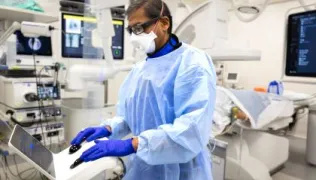Guy’s and St Thomas’ completes a week’s worth of surgery in one day to beat the backlog
Tuesday 15 November 2022

Some of the theatre staff who supported the recent HIT list
Surgeons at Guy’s and St Thomas’ carried out a week’s worth of operations in one day to help reduce the surgery backlog.
Eight men with prostate cancer underwent a robotic-assisted radical prostatectomy, which was the first time in the UK that one hospital has completed eight cases of this kind in one day.
The Trust has developed a super-efficient but safe programme to maximise the number of patients treated using high intensity theatre lists – known as HIT lists. They focus on one type of procedure at a time, take place at weekends, and require careful planning to select suitable patients.
So far the Trust has held 17 HIT lists and treated 344 patients across eight specialities, including gastrointestinal, gynaecology, orthopaedics and ear nose and throat (ENT).

Mick Jennings, from West Dulwich in south London, was one of the eight men who recently had a robotic-assisted radical prostatectomy at Guy’s Hospital.
The 59-year-old said: “It was great – I was told that the surgery was part of a HIT list beforehand, so I was prepared for everything to be quicker than usual.
“You could tell the staff were really energised with the concept and really keen to do their best. I didn’t find the pace a problem at all – I found they were trying super hard to do it well.”
Mick, who is an anaesthetist, went home the next day and is recovering well.
He said: “When I went back to the clinic all the other men who had the op were there too and we sought each other out – it made us feel like a bit of a gang.
“Having the surgery at the weekend didn’t make any difference at all. I was just happy that I could have the surgery as quickly as possible, and I’m looking forward to getting on with my life again.”

Mr Ben Challacombe, a consultant urological surgeon at Guy’s and St Thomas’ who led the surgery, said: “We have taken a week off our waiting list by carrying out these surgeries in one day – usually we would do six to eight of these procedures in a week.
“Everyone involved in the HIT list from the theatre and urology teams were energised. We learnt how to work in parallel and everyone felt part of something special. We were focussed on high quality throughout and no cases were rushed.”
The innovation and organisation of the HIT lists has been led by Dr Imran Ahmad, consultant anaesthetist and deputy clinical director for anaesthesia and theatres at Guy’s and St Thomas’.

Dr Ahmad said: “For many surgical procedures, the time required to perform the actual surgery is significantly less than the time spent preparing and anaesthetising the patient, setting up the equipment and helping the patient to recover – in some cases the operating time can be as little as 30% of the duration of the whole operating list.
“We have looked at every aspect of the patient’s pathway in detail to see where we can safely improve on efficiency, save time and parallel process in order to increase the surgeon’s operating time, by reducing non-operative time. It requires a dedicated multidisciplinary team and lots of preparation, which is the key to our success. It’s a bit like a Formula 1 pit stop crew where you have people who are all well trained and work together to do something very efficiently and safely.
“Our HIT lists have been so efficient that we have never overrun, despite the large number of cases per list, and our on day cancellation rate is less than 0.5% which is much lower than the national average.”
What does the HIT list involve?
- Increasing the number of anaesthetic, surgical and theatre staff in order to minimise the turnaround time between cases, making more time available for the surgeon to operate. In some cases this has been over 95% of the day
- Using two theatres and three teams, the surgeon can go between cases without having to wait for the patient – this allows for many more cases to be done in the same time period
- Several multidisciplinary meetings led by Dr Ahmad are required for each HIT list to select suitable cases, patients and team members and to plan the equipment and order of the lists – they include managers, administration staff, therapists, nurses, pharmacists, anaesthetists and surgeons.
Last updated: November 2022
Contact us
If you're a journalist and have a media enquiry, please contact us.
Phone: 020 7188 5577
Email: [email protected]



